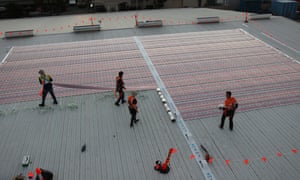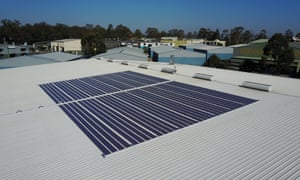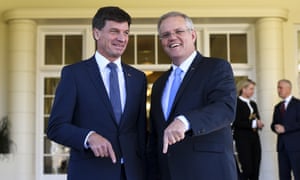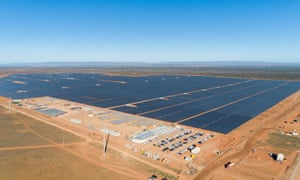Extract from The Guardian
Australian physicist says technology could make signing up for energy accounts as easy as a mobile phone subscription
An Australian physicist is leading a push to pioneer a new type of
low-cost solar energy he believes could make signing up for energy
accounts as straightforward as taking up a mobile phone plan.
In May last year, the University of Newcastle professor Paul Dastoor used organic printed solar cells to power screens and displays at an exhibition in Melbourne.
Less than one millimetre thick and held down with double-sided sticky tape, the panels are similar in texture to a potato chip packet and can be produced for less than $10 per square metre.
Dastoor has been working on the technology for more than a decade, but has now begun a 200 square-metre installation – the first commercial application of its kind in Australia and possibly the world.
“The low cost and speed at which this technology can be deployed is exciting as we need to find solutions, and quickly, to reduce demand on base-load power – a renewed concern as we approach another summer here in Australia,” he said.

In May last year, the University of Newcastle professor Paul Dastoor used organic printed solar cells to power screens and displays at an exhibition in Melbourne.
Less than one millimetre thick and held down with double-sided sticky tape, the panels are similar in texture to a potato chip packet and can be produced for less than $10 per square metre.
Dastoor has been working on the technology for more than a decade, but has now begun a 200 square-metre installation – the first commercial application of its kind in Australia and possibly the world.
“The low cost and speed at which this technology can be deployed is exciting as we need to find solutions, and quickly, to reduce demand on base-load power – a renewed concern as we approach another summer here in Australia,” he said.

And as Canberra is again gripped by energy policy inertia, he said the commercial pilot was an example of industry and academia “just getting on with things”.
“If we reflect on where we’ve come from in the last decade and what we’ve seen in the last couple of weeks in Canberra, one of the things this project highlights is that universities and industry are coming together to just to get on with things and that’s exciting.”
The printed solar technology is not as efficient as the silicon-based one, and degrades much faster.
But Dastoor believes its low production and installation costs would make it competitive.
“The point of this technology is that if you look at it in terms of raw efficiency numbers, it’s much lower than typical silicon cells [and] it doesn’t last as long but actually those aren’t the important numbers,” he said.
“The question is how much does the energy cost? These materials are so cheap to make, manufacture and install that when you calculate the total cost of energy when manufacturing at scale, it’s going to give you a competitive product.”
Dastoor said it would be easy for companies to sell energy “plans” for consumers to sign up in the same way they do with mobile phones.
The commercial installation was completed in a day by five employees, and a lab-size printer can produce hundreds of metres of the product in one day.

“The caveat to that is I’m obviously not sure exactly how the commercial reality will manifest, but if I was going to guess I would say that this technology is one that does not last an extremely long time [but] is also likely to improve rapidly,” he said.
“Both of those factors are similar with what we faced with mobile phones [so] I think it points to a model where you will simply have all of that done for you – it will be some sort of plan with constant upgrade and replacement.
“The cost to produce it is so low and to roll out another set of solar cells is going to be extremely easy. I think over time our current picture of how we view solar energy and cells is going to fundamentally change.”
The pilot installation is due to last six months, and is the final stop before the technology becomes more widely available in the next few years.











It was only a week ago that then-treasurer Morrison was hugging Australia’s Liberal party then-PM Malcolm Turnbull at a media call and pledging allegiance to his embattled captain. Asked if he himself had any leadership ambitions, the member for Cook responded: “Me? This is my leader,” and embracing the man, “I’m ambitious for him.”
Turnbull had survived a leadership vote against rival Peter Dutton, 48-35. Less than a week later, Turnbull was finished and Morrison’s slimmer margin of 45-40 had seen off Dutton and he became PM.
"Morrison is a proud and public worshipper at the Horizon Church, which, like Hillsong, is Pentecostal"
He is a neoliberal and as treasurer he has governed neoliberally. Wage growth in Australia is stagnant, underemployment is rife. One of his earliest speeches was to condemn welfare recipients as the “taxed nots”, yet the policy he was most committed to pursue was the $65bn tax cuts for corporate Australia, including $17bn for the banks – the banks that are now recommended for criminal charges, from a banking royal commission Morrison described as a “populist whinge”.
Who is such a person to lead this country? Well, if his own propaganda’s to be believed, a very holy man. Morrison spoke of his “personal faith in Jesus Christ” in his 2008 maiden speech, in which he also thanked pastors Brian Houston and Leigh Cameron of what has been described as a “money machine”, the Hillsong Church, for their “great assistance” to him. Citing Houston as “a mentor”, Morrison is a proud and public worshipper at the Horizon Church, which, like Hillsong, is Pentecostal, and similarly an “American-style mega-church ... where the gospel of prosperity is preached in an auditorium that can accommodate over 1,000 evangelicals” as described in a 2012 profile of Morrison in the Monthly.
Drilling down into what constitutes the “prosperity doctrine” of these Protestant sects provides some context for neoliberal Jesusing, Scott Morrison-style. Walking away from materialism is something we humble Catholics understand as a “counsel of perfection” – Christ’s instruction in Matthew 19:21 is literally “If you want to be perfect, go, sell your possessions and give to the poor, and you will have treasure in heaven. Then come, follow me.” But the theology of megachurches like Morrison’s inverts these values. Here, the message is that earthly riches result as a recognition of God’s favour. It’s an apologia for wealth and privilege and delivered with some pomp – as I learned when I spent a year hidden in his mentor Houston’s Hillsong congregation.
Yes, in a collection of carefully chosen pastel outfits, I squatted among the Hillsong faithful for a year, researching a “Christian drag” act cabaret. To hear Morrison espouse his own faith associations is to be reminded of megachurch marketing techniques – the deliberately chosen, good-looking “greeters” deployed to lead the nervous and the lonely to their seats, rock stadium theatrics concurrent with a “collection plate” that took your credit card details, and hand-on-heart gestural sermonising of the prosperity doctrine’s seductive heresies. The biblical pretext cited for material wealth as a sanctification of a blessed elect was provided by bible passages like Joel 2:23-25 and Proverbs 3:10 that my own tradition reads in the precisely opposite way.
The idea was to parody my discoveries, but there’s little one can add to scripts that read “Speak your faith, start seeing miracles ... Owner of your first home! Best-selling author ... Businessman who is prosperous and fruitful! Speak it into being! Speak it into being! Speak it into being! Amen!” – which is authentic Hillsong, by the way. An arena-show marriage of God and mammon was affected with triumphal choruses, syncopated clapping, marching drums, and always – always – the exhortation to consider wealth as an earned blessing of niche piety, something within reach if more donations were handed over, more church-brand merchandise bought. At a service’s conclusion, business directories were handed out. The encouragement was strong that God’s favour should remain in-house.
“You cannot serve both God and money,” said Jesus in the Sermon on the Mount. “The best form of welfare is a job,” said Morrison as treasurer, when shown that his own 2015 budget punished the poor most of all.
• Van Badham is a Guardian Australia columnist